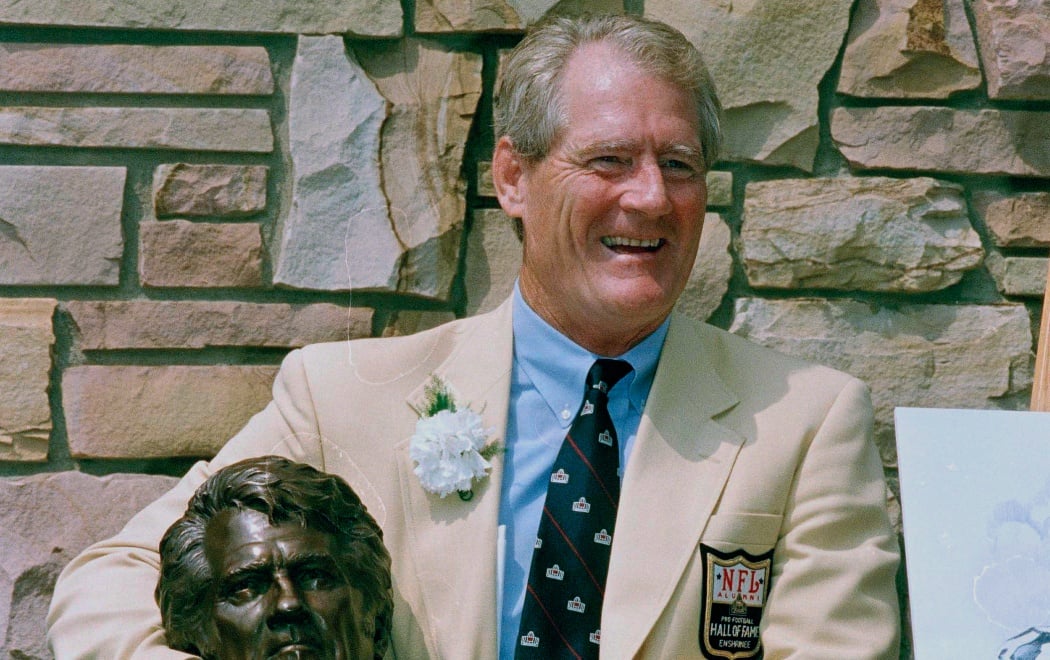Gold Jacket Spotlight: Jackie Smith Never Quit

If Hall of Fame tight end Jackie Smith had played in an era when young high school football players received ratings, he would not have been listed as a 5-star college recruit.
More like no stars when your three varsity seasons included only a handful of games at tiny Kentwood High School in northeast Louisiana. Injuries continually sidelined Jackie. A torn Achilles tendon wiped out his sophomore year, an ankle injury eliminated all but the second half of the last game of his junior season and a hip injury ended his senior season after four games.
While any future in football seemed doubtful, Jackie excelled in track and field. He ran the individual quarter-mile race and as a member of the school’s mile relay team. He also competed in the low and high hurdles, winning a state championship.
That success grabbed the attention of track coaches at Northwestern Louisiana State College (now Northwestern State University of Louisiana). They offered him a scholarship, covering half his costs.
But Jackie and his family needed him to receive a full scholarship to afford college. The school proposed a novel solution.
“They told me, ‘If you go out for the football team and don’t quit, we can give you a full scholarship,’” Jackie recalled. “I didn’t even have to play. Just don’t quit.”
He didn’t quit, and that “determination of unbridled fierceness” – as Jackie’s Hall of Fame Enshrinement presenter put it in 1994 – are remembered this week in the Gold Jacket Spotlight.
Jackie not only fulfilled his commitment to the Northwest State football team, but he also contributed on the field. He led the Demons in receiving his last two seasons, albeit with modest stats on the heavily run-oriented team.
Unbeknownst to Jackie, his tenacity, strength and speed caught the eye of a scout for the St. Louis Cardinals. The team selected him in the 10th round (129th player overall) of the 1963 NFL Draft.
“I was the most surprised guy in the world when that happened,” Jackie told an interviewer about being drafted by anyone in either the NFL or rival AFL. “I thought someone had made a mistake. But it worked out OK.”
More than OK.
Jackie played immediately and in Week 5 of his rookie season turned in a 212-yard game – more yardage than his senior college season – with two touchdowns in a 24-23 victory over the Pittsburgh Steelers. By Year 3, he became a full-time starter and appeared in the first 121 games of his pro career until a knee injury sidelined him in 1971. After rebounding with three solid seasons, injuries slowed him again in 1975 and 1976, but Jackie still played in 198 regular-season games over 15 years with the Cardinals, retiring in 1977. He was named to five consecutive Pro Bowl teams (1966-70).
His best season statistically came in 1967, with 56 receptions for 1,205 yards and nine touchdowns. The yardage ranked third in the league, only 60 yards from leading the entire NFL, and it was nearly a thousand yards more than the average for all other tight ends that year.
Jackie came out of retirement in 1978 to play one season with the Dallas Cowboys, joining the team in Week 5 and providing leadership and guile on a team that reached the Super Bowl. He reportedly still could run the 40-yard dash in 4.6 seconds as a 38-year-old.
He retired again after the 1978 season, and at that time his 480 receptions, 7,918 receiving yards and 40 touchdowns ranked first in NFL history for all tight ends. His 16.5 yards-per-catch average remains the highest among tight ends enshrined in the Pro Football Hall of Fame.
“It’s hard to put yourself in the category of one of the great players of all time,” Jackie said in a television interview a few years ago. “It’s nice to get to the ‘S’s’ and see your name in there.”
‘S’ for Smith. ‘S’ for star.
Stories From The Hall of Fame Archives: Fouts Stuns Browns in First of 51 Career Comeback Victories
In a Week 8 matchup in 1974 against the Cleveland Browns, Fouts found the magic that would make him a future Hall of Famer.
Top Photos of NFL Season Revealed in Hall's 53rd Annual Photo Contest
Detroit Lions photographer captures photograph of the year.